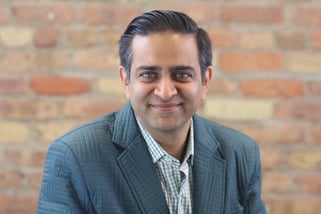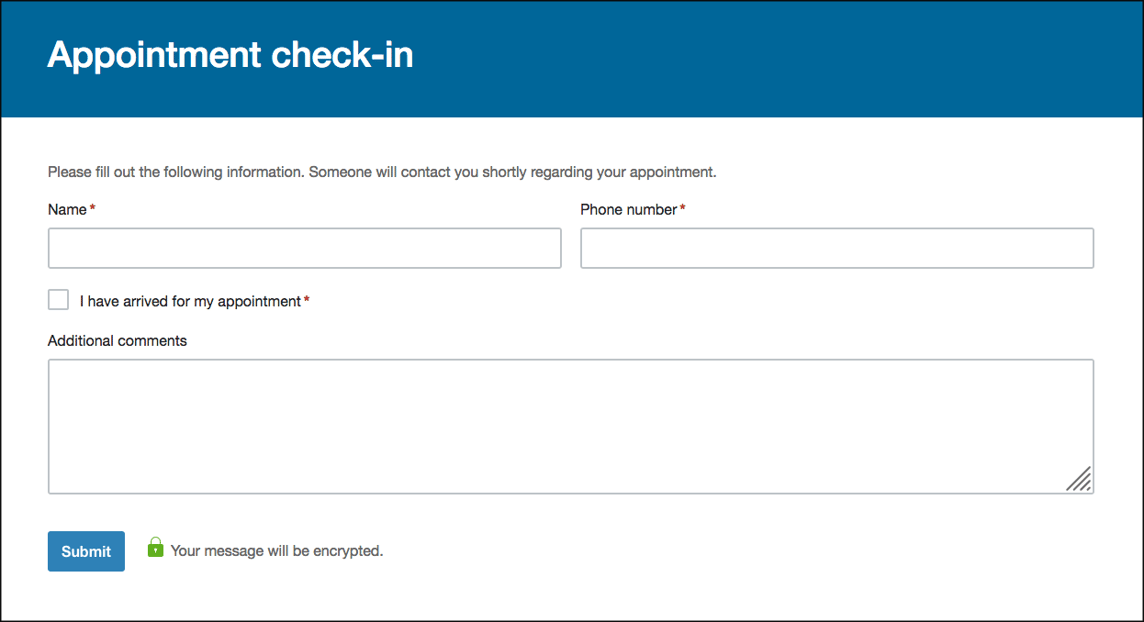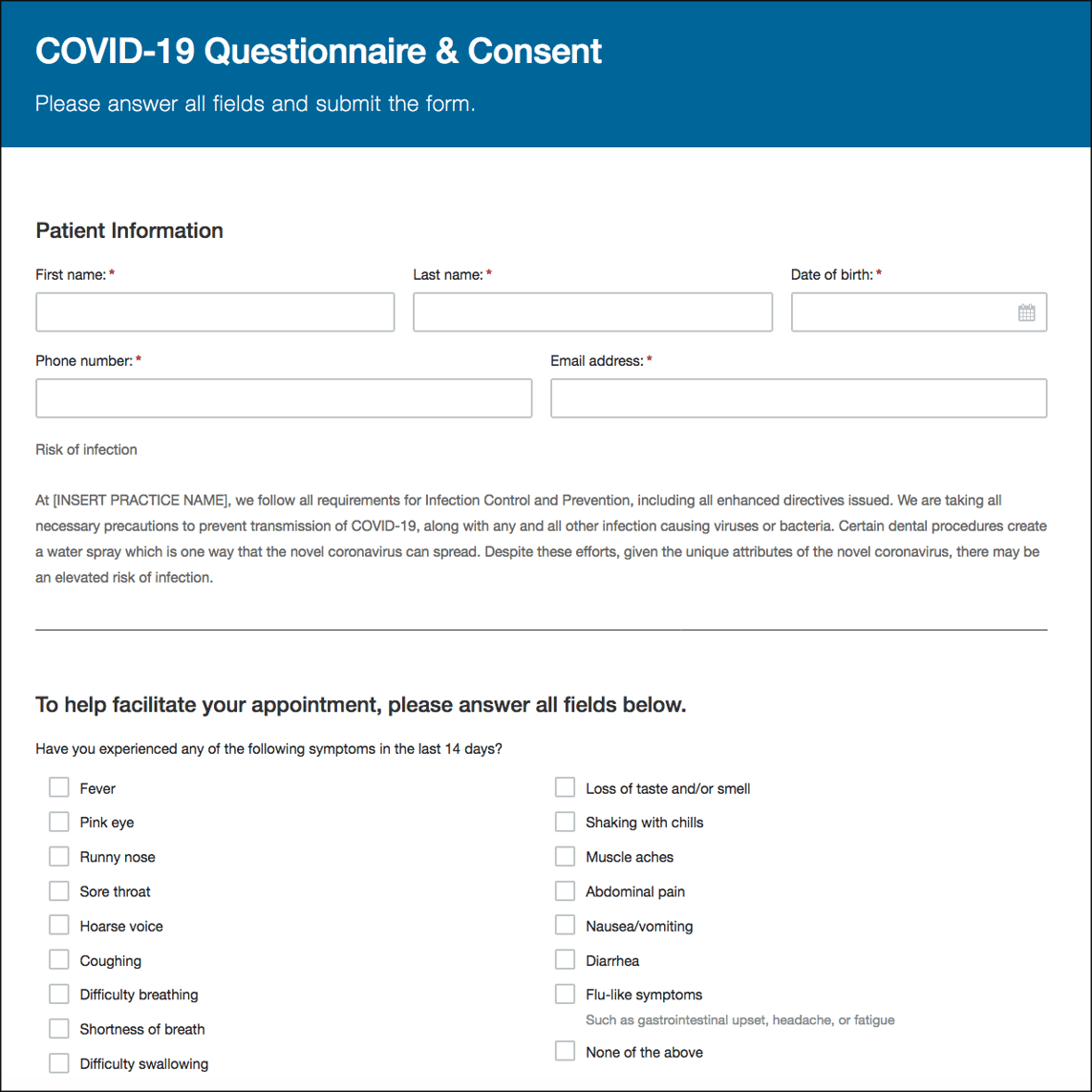Forms
Customer success story: safely reopening with Hush™ Secure Forms

It’s back to business as usual, or is it?
With the reopening of our businesses, it’s tempting to feel that life is finally becoming normal again. It may be moving in that direction, but there are still plenty of considerations we must give to the current state of the pandemic. Caution during reopening is necessary.
If you manage a healthcare practice, you’re likely sorting through your options to safely reopen and care for your patients. In this post, we’re presenting a customer success story that explores how a dentist safely continued providing emergency care at the height of the pandemic and recently reopened his elective services using web forms as part of his strategy to maintain safe contact with his patients.
Meet Neil J. Gajjar, DDS
 Neil J. Gajjar, DDS, MAGD, AGD immediate past president, is a general dentist from Mississauga, Ontario. Gajjar is an active member of the Academy of General Dentistry (AGD) and the Canadian Dental Association. He lectures on managing medical emergencies in the dental office and previously served as oral pathology lecturer and clinical instructor at the Canadian Academy of Dental Hygiene and clinical instructor in the Oral Diagnosis and Emergency clinics at the University of Toronto Faculty of Dentistry. Gajjar is a fellow of the Academy of Dentistry International, Pierre Fauchard Academy, International College of Dentists and American College of Dentists. Neil J. Gajjar, DDS, MAGD, AGD immediate past president, is a general dentist from Mississauga, Ontario. Gajjar is an active member of the Academy of General Dentistry (AGD) and the Canadian Dental Association. He lectures on managing medical emergencies in the dental office and previously served as oral pathology lecturer and clinical instructor at the Canadian Academy of Dental Hygiene and clinical instructor in the Oral Diagnosis and Emergency clinics at the University of Toronto Faculty of Dentistry. Gajjar is a fellow of the Academy of Dentistry International, Pierre Fauchard Academy, International College of Dentists and American College of Dentists. |
Dr. Neil J. Gajjar owns a private dental practice in Mississauga, Ontario. In mid-March, he received an email from the Royal College of Dental Surgeons of Ontario, informing him that dental practices must close immediately except to offer emergency care.
Returning to my practice after quarantine
The news that I had to close my practice except for emergent care was unprecedented and a bit of a shock. I’d just returned from a trip to the US, and I chose to quarantine myself for 14 days, although at that time it wasn’t mandatory. It was the prudent decision.
When I returned to my practice, I found a stack of intake forms on my desk that were damp. When I asked why, I learned that because the forms had gone through multiple hands and multiple areas in the office, my staff had attempted to sanitize them by spraying them with disinfectant. They were difficult to read, and it was clear that paper forms would no longer work for us. It was also clear that we would have to examine all areas of the practice to make sure we responded appropriately to this situation.
That evening, I called my staff together and decided that going forward, we would take half an hour at the end of every day and look at what we could do to reduce contact, increase efficiency, and streamline operations.
Reducing contact with patients was going to be difficult because touchpoints are very important to a dental practice. I wanted to figure out a way to maintain positive interaction with patients while limiting physical contact as much as possible.
In the weeks that followed, we put together a process using web forms to help us continue to safely see patients. Here’s how we did it:
Intake forms patients can fill out and sign at home
Eliminating time spent in the waiting room was a priority for us. By using intake forms patients could fill out at home, our patients could arrive at their appointments ready to receive care without having to take the time to fill out paper forms. This would also give me time to review forms before the appointments. Certain conditions might prompt me to schedule an appointment in the morning rather than the afternoon, or I might want to start or stop certain drugs. Web forms allow me to do all of that ahead of time.
.png?width=1143&name=medical%20form-border%20(2).png)
Click here to view the entire form. This form is modeled on the medical history form Dr. Gajjar uses in his practice.
Web forms that help manage a parking lot waiting area
We had to figure out a way to efficiently and comfortably welcome patients to their appointments. We settled on a check-in form that would allow a patient to wait in their car. We now send a link to the patient ahead of their appointment, and when they arrive, they can click on the link and alert my front desk to their arrival. My staff can then call the patient when I’m ready to see them.

Web forms to manage staff and patient COVID-19 checks
Part of managing a practice during a pandemic is monitoring the health of those who enter the building. It’s necessary to document the health of both staff and patients. Another web form makes this extra step in our schedule non-disruptive and effectively allows us to keep track of everyone’s health.
Staff members can click on a link each morning when they arrive at the office, fill in the necessary information (e.g., temperature, symptoms, exposure, etc.), and submit the form. Patients can click on a link sent to them after they submit their intake form and fill in their information before they arrive at our office.
The forms can then be reviewed and filed away as PDFs, documenting our due diligence in monitoring the health of our staff and patients.

Click here to view the entire form. This form is modeled on the questionnaire Dr. Gajjar uses in his practice.
Web forms provide a good impression to our patients
Today, conducting our lives and businesses with some peace of mind depends on everyone taking responsibility for doing the right thing. If it’s clear to patients that my practice is taking the visible steps to keep them safe on the front end, then they can feel more confident that we’re doing the right things to keep them safe on the backend as well.
By using these three web forms to manage my practice during the pandemic, I’m able to care for my patients in a manner that allows them to feel safe when they arrive for their appointments.
Want to start using web forms to reopen your practice today?
|
If you manage a healthcare practice, you’re likely sorting through your options to safely reopen and care for your patients. In this post, we’re presenting a customer success story that explores how dentist Dr. Neil Gajjar safely continued providing emergency care at the height of the pandemic and recently reopened his elective services using web forms as part of his strategy to maintain safe contact with his patients. Related posts: |
Overwhelmed by the business side of private practice? In this guide, therapists share 20 ways they've offloaded what drains them, to create more space for the work they love.



.jpg?noresize&width=460&name=%E2%80%9CThank%20goodness%20Hushmail%20is%20so%20easy%20to%20use.%20I%20don%E2%80%99t%20have%20to%20learn%20a%20lot%2c%20and%20that%E2%80%99s%20a%20relief%20when%20there%20are%20so%20many%20other%20things%20to%20think%20about%20right%20now.%E2%80%9D(1).jpg)
